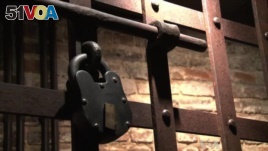February 03,2014
ALEXANDRIA, VIRGINIA — The award-winning movie 12 Years a Slave is based on the memoir of Solomon Northrup, a free black man from New York who was kidnapped in Washington in 1841. It is also the story of the notorious slave trader who sold him into slavery, James Birch.
In Alexandria, Virginia, just outside of Washington, Birch would become an owner of a slave pen where men, women and children were held before being sold as property. Today, all that remains of the site is a single building -- now home to a civil rights organization and a small museum about slavery.

Thousands of slaves passed through the doors of the house in Alexandria, Virginia and the Freedom House Museum downstairs provides a glimpse about what they experienced. As many as 60 men at a time were held in this small space, separated from their families.
Ugandan-born curator Julian Kiganda can not imagine what it was like for them, to know they might never see their loved ones again.
“Seeing that African-Americans had experienced on a regular basis, the separation of family. That for me was just so heartbreaking,” he said.
Most of the slaves had worked on local plantations picking tobacco. When the soil was exhausted, they were sold to plantations further south to pick cotton, says Audrey Davis, head of Alexandria's Black History Museum.
“They were coming from a variety of places, and then being held in the slave pens until they were shipped out, or until someone was buying them directly from the pen, and then they would be brought out for inspection,” she said.
The slave pen took up an entire block, and was one of the most lucrative in the country. There was a kitchen, infirmary, dining area and an outdoor courtyard for exercise. The traders knew that healthier looking slaves would command higher prices, and even gave them new clothes.
“The tailor shop would create the clothes that the slaves would wear at the market so they would look expensive," Kiganda said. "For the slaves, they would try to get rid of these clothes as soon as they could because they did not want to be reminded of being sold at market.”
The slaves were sold for up to four times what the traders had paid for them.
“People would pay $1,200 for a slave, back in those days, which is the equivalent of almost $30,000. And so that one slave could farm 800 pounds of cotton in one day," Kiganda said.
The metal door in the museum is a copy. But the bars on the windows and brick walls are original.
Jacquelyn Nordorf, visiting from California, says it is chilling to imagine slaves crowded against the walls.
“It saddens me but it is our history," she said. "It was scary to be in a place where the slaves were actually kept and these people were sold for their lives.”
When they were transported, the slaves were shackled together to prevent escape and put on ships, or forced to walk long distances to plantations in the south.
Visitors are encouraged to touch these slave chains.
“We felt it was important for people to have the ability to actually feel these things and feel the reality of what happened here,” Kiganda said.
Some people feel the presence of spirits here. The house now belongs to the Northern Virginia chapter of the Urban League -- an organization that empowers African-Americans. Chief Executive Officer Cynthia Dinkins and her staff say they have heard and seen things they can't explain.
“I felt something brush against me, but I didn’t feel threatened at all," she said. "And they [staff members] said, yes, yes, we’ve experienced things like that, doors opening and closing, footsteps.
The slave pen was closed during the American civil war, fought between the northern Union and southern Confederacy, where slavery supported the economy. After Southern-backed Alexandria surrendered to Union soldiers in 1861, the pen was turned into a prison. It was used to jail unruly Union soldiers, and ironically, Confederate soldiers, who found themselves captured and held as the slaves had been.